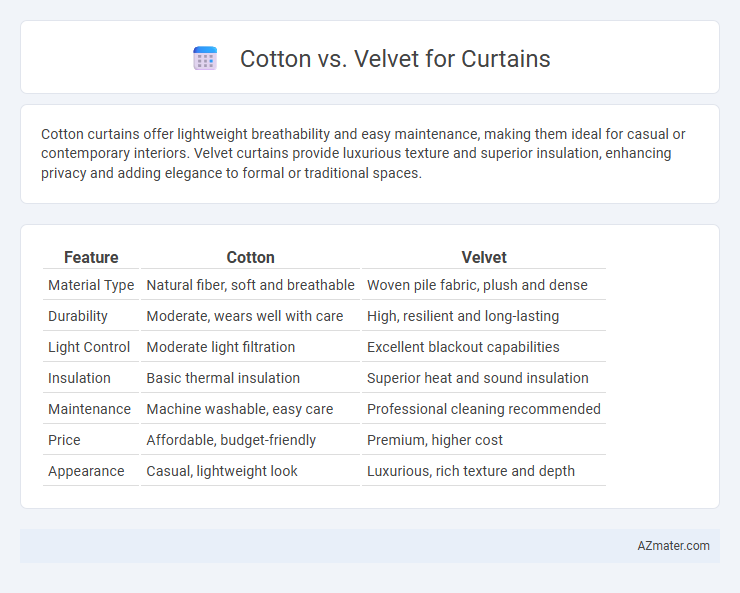Cotton curtains offer lightweight breathability and easy maintenance, making them ideal for casual or contemporary interiors. Velvet curtains provide luxurious texture and superior insulation, enhancing privacy and adding elegance to formal or traditional spaces.
Table of Comparison
| Feature | Cotton | Velvet |
|---|---|---|
| Material Type | Natural fiber, soft and breathable | Woven pile fabric, plush and dense |
| Durability | Moderate, wears well with care | High, resilient and long-lasting |
| Light Control | Moderate light filtration | Excellent blackout capabilities |
| Insulation | Basic thermal insulation | Superior heat and sound insulation |
| Maintenance | Machine washable, easy care | Professional cleaning recommended |
| Price | Affordable, budget-friendly | Premium, higher cost |
| Appearance | Casual, lightweight look | Luxurious, rich texture and depth |
Introduction: Cotton vs Velvet Curtains
Cotton curtains offer lightweight breathability and natural moisture absorption, making them ideal for casual, airy interiors and warmer climates. Velvet curtains provide rich texture and heavy insulation, enhancing privacy and blocking light effectively in colder environments or formal settings. Choosing between cotton and velvet affects room ambiance, thermal performance, and overall aesthetic, aligning with design goals and functional needs.
Material Overview: Cotton and Velvet
Cotton curtains offer breathability, natural fiber comfort, and ease of maintenance, making them ideal for a casual, light-filtering window treatment. Velvet curtains provide a luxurious, heavy texture with excellent insulation and soundproofing qualities, often chosen for formal or cozy settings. The material density and weave of velvet create a rich appearance, while cotton's versatility suits various decor styles and climates.
Aesthetic Appeal and Style Comparison
Cotton curtains offer a natural, breathable texture with a crisp, casual look that complements minimalist and contemporary interiors, while velvet curtains present a rich, plush appearance that enhances luxury and elegance in traditional or opulent settings. The matte finish and subtle drape of cotton create a light, airy ambiance, contrasting with velvet's dense pile and lustrous sheen, which add depth and warmth to a room. Choosing between cotton and velvet curtains depends on the desired aesthetic: understated simplicity versus dramatic sophistication.
Durability and Longevity
Cotton curtains offer moderate durability with natural breathability but tend to fade and wear out faster in sunlight exposure. Velvet curtains provide superior durability due to their dense weave and heavier fabric, maintaining appearance and texture over extended use. Velvet's longevity makes it ideal for high-traffic areas, while cotton suits lighter-use spaces requiring frequent washing.
Light Control and Insulation Properties
Cotton curtains offer moderate light control, allowing natural light to filter through while providing basic insulation suitable for mild climates. Velvet curtains excel in blocking out light completely and provide superior insulation due to their dense, heavy fabric, making them ideal for maintaining room temperature and enhancing privacy. Choosing velvet over cotton results in better thermal regulation and significantly improved darkness in living spaces.
Maintenance and Cleaning Requirements
Cotton curtains require regular washing and gentle handling, often machine washable but prone to shrinkage and fading if exposed to harsh detergents or high heat. Velvet curtains demand more delicate care, typically needing professional dry cleaning due to their dense pile and sensitivity to water, which can cause texture damage or color change. Both fabrics benefit from routine vacuuming to remove dust, but velvet curtains generally require less frequent deep cleaning compared to cotton.
Cost and Affordability
Cotton curtains typically offer a more affordable option, with prices ranging from $10 to $30 per yard, making them ideal for budget-conscious homeowners. Velvet curtains, known for their luxurious texture and heavier weight, usually cost significantly more, averaging between $40 and $100 per yard. Choosing between cotton and velvet largely depends on balancing upfront fabric costs with desired aesthetic and insulation benefits.
Best Rooms for Cotton vs Velvet Curtains
Cotton curtains are ideal for casual and bright rooms such as kitchens and living areas where natural light and breathability are essential, offering a light and airy feel. Velvet curtains suit formal spaces like dining rooms and bedrooms, providing a luxurious, heavier texture that enhances insulation and light blocking. Choosing cotton or velvet depends on desired ambiance, insulation needs, and room functionality.
Environmental Impact and Sustainability
Cotton curtains are biodegradable and often produced using natural fibers, making them more sustainable when sourced organically and dyed with eco-friendly materials. Velvet curtains, typically made from synthetic fibers like polyester or a blend, have a larger carbon footprint due to energy-intensive manufacturing and slower biodegradation. Choosing organic cotton curtains supports environmental conservation and reduces chemical pollution compared to conventional velvet options.
Final Verdict: Which Curtain Fabric Suits You?
Cotton curtains offer breathability, easy maintenance, and a lightweight feel, making them ideal for casual, airy spaces or warm climates. Velvet curtains provide a luxurious texture, excellent insulation, and superior light-blocking properties, perfect for bedrooms or formal living areas requiring privacy and elegance. Choose cotton for versatility and comfort, while velvet suits those seeking opulence and enhanced thermal performance.

Infographic: Cotton vs Velvet for Curtain
 azmater.com
azmater.com